The AMD FX (Bulldozer) Scheduling Hotfixes Tested
by Anand Lal Shimpi on January 27, 2012 12:47 PM ESTMixed Workloads: Mild Gains
The one thing all of the following benchmarks have in common is they feature more varied CPU utilization. With periods of heavy single and all core utilization, we also see times when these benchmarks use more than one core but fewer than all.
SYSMark has always been a fairly lightly threaded test. While there are definite gains seen when going from 2 to 4 cores, this is hardly a heavily threaded test. The performance impact of the hotfixes is negligible in the overall performance result or across the individual benchmark suites however:
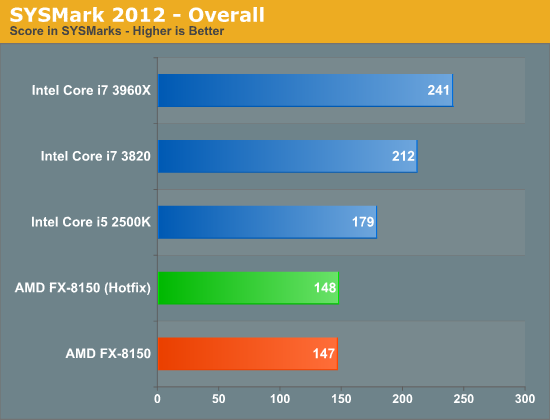
Our Visual Studio 2008 compile test is heavily threaded for the most part, however the beginning of the build process uses a fraction of the total available cores. The hotfixes show a reasonable impact on performance here (~5%):
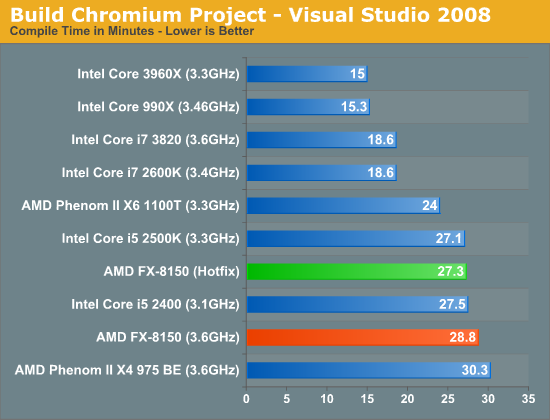
The first pass of our x264 transcode benchmark doesn't use all available cores but it is more than just single threaded:

Performance goes up but only by ~2% here. As expected, the second pass which consumes all cores in the system remains unchanged:
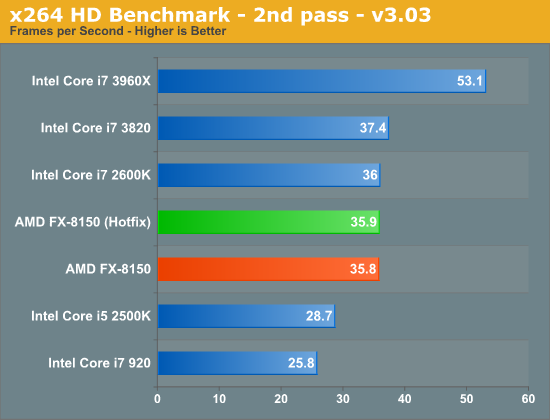
Games are another place we can look for performance improvements as it's rare to see consistent, many-core utilization while playing a modern title on a high-end CPU. Metro 2033 is fairly GPU bound and thus we don't see much of an improvement, although for whatever reason the 51.5 fps ceiling at 19x12 is broken by the hotfixes.

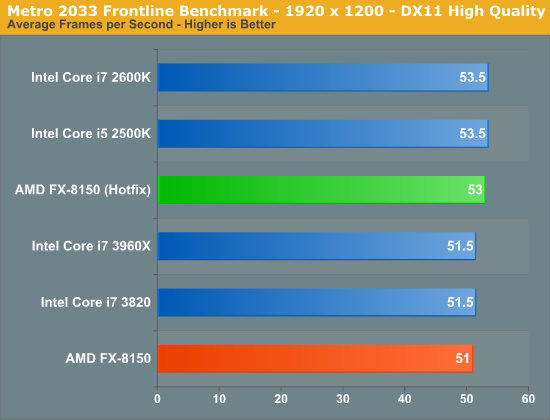
DiRT 3 shows a 5% performance gain from the hotfixes. The improvement isn't enough to really change the standings here, but it's an example of a larger performance gain.
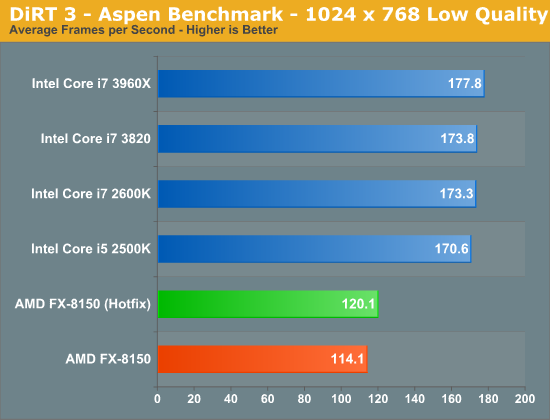
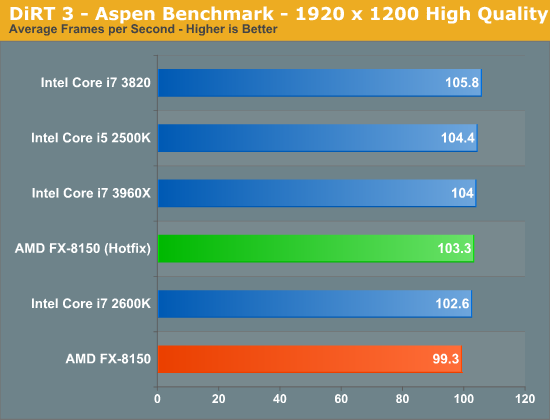
Crysis Warhead mirrors the roughly 5% gain we saw in DiRT 3:
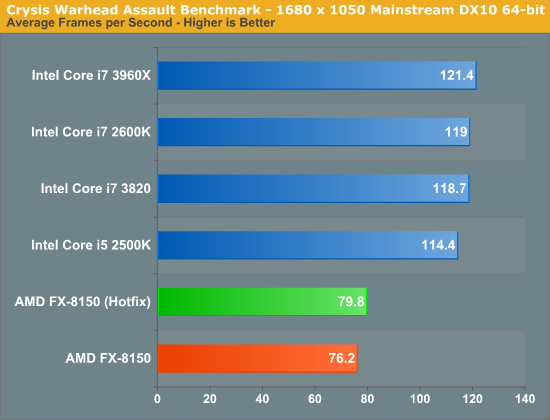
Civilization V's CPU bound no render results show no gains, which is to be expected. But looking at the average frame rate during the simulation we see a 4.9% increase in performance.
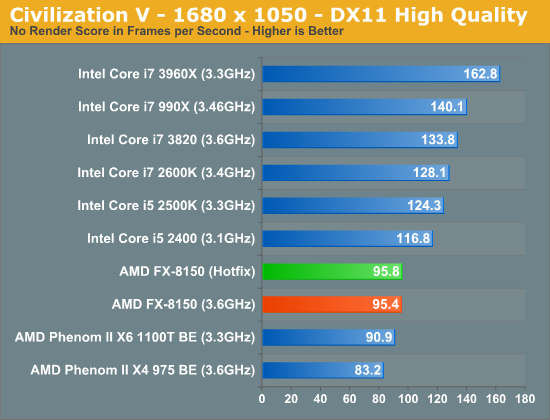
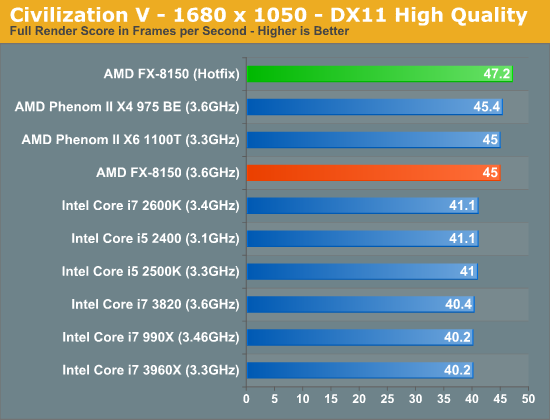










79 Comments
View All Comments
Beenthere - Friday, January 27, 2012 - link
The Win 7 Hot Fix speaks for iteslf. As noted it's a small bump - but it's free. It's not AMD's fault that Microsucks O/Ss sucks. It's reported Linux does a better job of scheduling, probably because it's used on a lot of servers with heavy work loads.I always tell people to buy what makes them happy. If you're happy with a product from a convicted criminal corporation and chose to support their efforts to eliminate consumer choice and drive up PC hardware prices - that's your choice and you're perfectly free to do so. Bashing AMD is not going to change reality however, no matter how disappointed you are in them.
In reality ANY of todays current model CPUs have more than enough computing power for 90+ percent of PC users. If all you do is run benchmarks then you could be misinformed...
http://www.theinquirer.net/inquirer/news/2120866/i...
gamerk2 - Friday, January 27, 2012 - link
Funny, considering different Linux distributions use different schedulers. Lets not also forget there is OVERHEAD to doing a lot of processing within the scheduler, and keeping track of thread/resource use can be a pain.sor - Saturday, January 28, 2012 - link
Huh? The process scheduler in Linux is dependent on which version of the kernel you have. Any current distribution should be using CFS. You may be confusing this with the options of IO schedulers.B3an - Friday, January 27, 2012 - link
Oh grow up you immature moron (typical Linux user!). And Apple are FAR worse now than MS ever was, as well as bigger. BTW it's not the 1990's anymore,frozentundra123456 - Saturday, January 28, 2012 - link
I cant believe people are still blaming Microsoft for bulldozers failure. It seems to me that the responsibility of a company is to bring out a product that works in the current environment, i.e. that works efficiently with win 7. Especially when you control a small portion of the market, you should make a product that "just works". You shouldnt expect the software to be rewritten for your product. And Intel doesnt seem to have any problem making processers that work efficiently with the current environment.Morg. - Tuesday, January 31, 2012 - link
I like the *could* be misinformed -- if Intel didn't want benchmarks and reviewers to like them, I'm pretty sure they wouldn't do anything for it ;)cigar3tte - Friday, January 27, 2012 - link
I don't normally bother, but there is way too many here...Worth wild = worthwhile
It's = its
Their = There
Your = you're
Losses = loses
And yeah, it's more of a free fix than free performance. Bulldozer users are getting back what was lost, rather than gaining something.
snouter - Friday, January 27, 2012 - link
"there are way too many"I don't normally bother either.
jonup - Saturday, January 28, 2012 - link
You can always look at a glass as half-full or half-empty.@typos: Sad part is that some of them are native speakers.
gevorg - Friday, January 27, 2012 - link
Can the Sandy Bridge CPUs benefit from this by any chance?